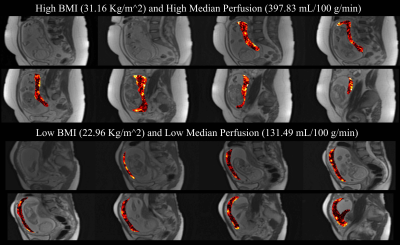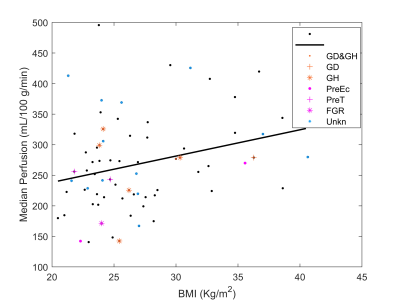Daniel Seiter1, Ruiming Chen1, Kai Ludwig1, Ante Zhu2, Dinesh Shah3, Oliver Wieben1,4, and Kevin Johnson1,4,5
1Medical Physics, University of Wisconsin-Madison, Madison, WI, United States, 2GE Global Research, Niskayuna, NY, United States, 3Obstetrics and Gynecology, University of Wisconsin-Madison, Madison, WI, United States, 4Radiology, University of Wisconsin-Madison, Madison, WI, United States, 5Biomedical Engineering, University of Madison-Wisconsin, Madison, WI, United States
1Medical Physics, University of Wisconsin-Madison, Madison, WI, United States, 2GE Global Research, Niskayuna, NY, United States, 3Obstetrics and Gynecology, University of Wisconsin-Madison, Madison, WI, United States, 4Radiology, University of Wisconsin-Madison, Madison, WI, United States, 5Biomedical Engineering, University of Madison-Wisconsin, Madison, WI, United States
Using analysis of placental VS-ASL MRI, a
statistically significant increase in placental perfusion with BMI is shown in
human subjects (n=71). Novel longitudinal data of placental perfusion is presented.

Figure 2. Placental perfusion maps overlaid onto
the reference M0 scans for two subjects, illustrating the difference between high perfusion with high BMI (top, 397.83 mL/100 mg/min, BMI = 31.16 kg/m2) and low
perfusion with low BMI (bottom, 131.49 mL/100 mg/min, BMI = 22.96 kg/m2).

Figure 3. Regression analysis of perfusion and BMI,
demonstrating a statistically significant positive relationship. (R2
= 0.076, p = 0.020) Adverse maternal outcomes are marked: Gestational diabetes
(GD), gestational hypertension (GH), preeclampsia (PrE), preterm labor
(preterm), and fetal growth restriction (FGR). If outcome data was not
available for a case, the data point is plotted as unknown (Unkn). The relationship between
maternal outcomes and perfusion will be investigated in a later work.